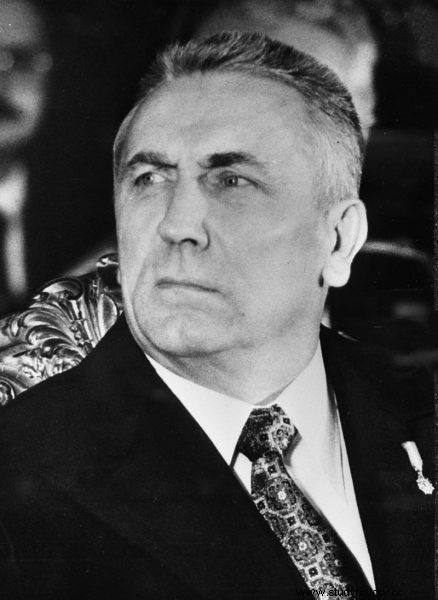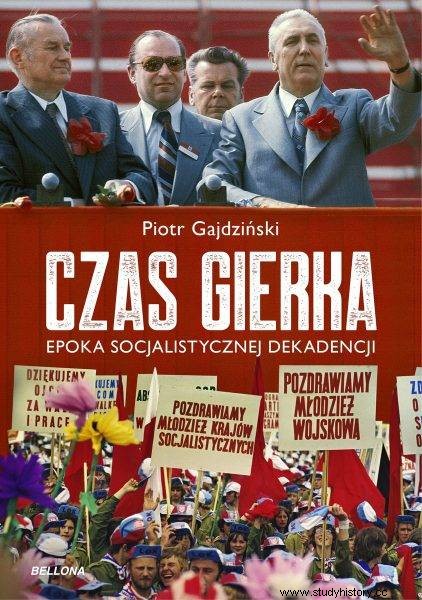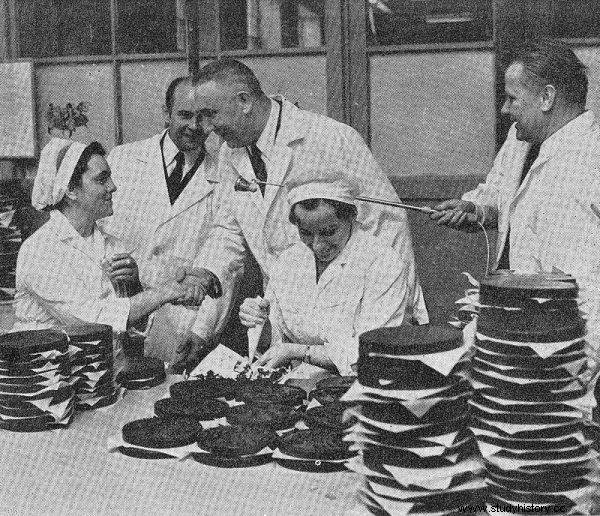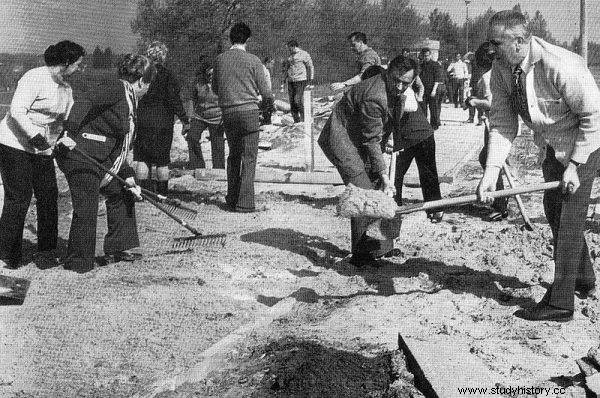The golden decade of Edward Gierek is remembered by many as a time of exceptional prosperity, a breath of modernity straight from the notorious West or loosening certain social and moral norms. In this praise, the propaganda of success is often forgotten, without which perhaps Gierek would not be so loved. Because if it was so good, what went wrong that suddenly it all collapsed?
Great hopes were placed in Edward Gierek when in December 1970 he took over the position of the First Secretary of the Central Committee of the PZPR after Władysław Gomułka. He was significantly different from his predecessor, which he liked to emphasize . Against the background of the modest, or even skimpy, Gomułka, who did not attach much importance to his image, well-groomed, well-groomed, and fluent in French, Gierek was so surprisingly good at the very beginning that it was enough to compare him to Western leaders. As Piotr Gajdziński writes in his book “Czas Gierka. The era of socialist decadence ”:
For a moment Gierek's strength came from the fact that he was different from Gomułka. He wore elegant, well-cut suits, colorful ties, and did not still have the grim face that characterized his predecessor. It liked, the aspiring nation was relieved to greet a leader whose entourage was not much different from that of the leaders of Western Europe or the United States.

Edward Gierek was significantly different from his predecessor, which he liked to emphasize.
Gierek's openness and charisma made him quickly popular. He knew how to win over people because he did not avoid contact with them . He traveled around the country, he paid "farm visits" to workplaces - not only in large cities, but also in small towns, and there he was looked at with sympathy, hope and gratitude, because, as Gajdziński notes, Gierek:
He seemed so caring and kind. That he walked among them in a helmet, sometimes in a white apron, he looked with satisfaction around the suddenly cleaned construction site or stroked the cows. That he was interested was most of all.
It was believed in the assurances of the new First Secretary of the Central Committee of the Polish United Workers' Party that he would "build a second Poland". And when he asked:"Will you help?", Apparently they all shouted unanimously in response:"We will help!". Until at least.
Read also:What did Edward Gierek do in retirement?
"For Poland to grow in strength and people to live more prosperously"
After coming to power, Gierek suspended the food price increases planned by Gomułka's team. In early 1971, the Soviet Union offered a $ 100 million loan to "regain peace for a neighboring nation." The money was used to buy food products.
When the shelves in stores ceased to glow empty, Gierek could start planning. And he planned on a grand scale. He wanted to accelerate the economic development of the country and thus improve the living conditions of citizens. He focused on huge investments, including the construction of Huta Katowice in Dąbrowa Górnicza, Fabryka Samochodow Małolitrażowych (from which the desired Fiat 126p left), Gdańskie Zakłady Rafineryjnych and the Northern Port .

The text was created, among others based on the book by Piotr Gajdziński “Czas Gierka. The era of socialist decadence ”, which has just been released by Bellona Publishing House.
New basins were also created, road networks were developed and investments were made in the chemical industry in Toruń and Płock. The Central Railway Station and Łazienkowska Route were built in Warsaw. In addition, almost three million new apartments have been commissioned. And all this in line with the slogan:"For Poland to grow in strength and people to live more prosperously". At the same time, it was not forgotten to inform about successes frequently. As the author of the book "Czas Gierka. The era of socialist decadence ”:
In newspapers, and above all on television, which is now becoming the main propaganda tube, information is published every day about successive successes, thousands of tons of pig iron flowing from metallurgical furnaces, about modern metal sheets produced by these steel mills, which will soon turn into new cars, washing machines, refrigerators.
Poland not only followed the path of the Western powers, but even caught up with them. And that was just the beginning!
Read also:What did engineer Karwowski and lieutenant Borewicz tell us about the People's Republic of Poland?
From gray to colorful reality
The sudden economic development was accompanied by changes in the everyday life of Poles. Wages increased, farmers gained free access to health care, paid maternity leaves extended, sales of refrigerators, washing machines, TVs and cars increased significantly, exotic products such as coffee, cocoa and citrus fruits were imported more often .
Symbols of Western prosperity and a modern lifestyle have also appeared in stores - chewing gum, Coca-Cola, jeans, Marlboro cigarettes. The first discos were created to replace the previously popular parties, and they enjoyed vodka, not sweet wine, and in large quantities. Censorship was also relaxed, thanks to which Zbigniew Herbert's Wiersze zebrane and Edward Stachura's Siekierezada were published, Western popular music was broadcast on the radio, and foreign films were broadcast in cinemas and television.

Edward Gierek During a visit to Zakłady 22 July (former E. Wedel) in Warsaw, 1972.
Poles lived not only better, but also more colorful. As Piotr Gajdziński notices:"compared to the era of Władysław Gomułka, life became more bearable and the prospects looked rosy". The author of the book "Czas Gierka ..." also mentions the memories of Ewa Mielcarzewicz, who was then a student of the Poznań University of Technology:
At the end of the sixties, Poland was gray-haired, some sort of “uniformed”, everyone was dressed in the same, or at least very similar. Suddenly, in the early seventies, colors, flowery dresses and skirts appeared.
Gierek had such a momentum that he created an almost new reality. Or at least everyone wanted to believe it.
You want candy, go to Gierek ...
… Gierek has it, he will give it to you. And if there is none, he will take a loan. The huge and numerous investments that Gierek and his team were planning required equally large amounts of money. And these neither grew on trees nor spilled out of Poles' pockets, so Gierek sought funds from his western friends. They were willing to offer loans, and the First Secretary of the Central Committee of the PZPR accepted them willingly, but the loans have this characteristic that at some point it is necessary to pay them back, and that was the problem .

The text was created, among others based on the book by Piotr Gajdziński “Czas Gierka. The era of socialist decadence ”, which has just been released by Bellona Publishing House.
Modernizing the economy took a lot of resources, the construction of some facilities, including Huta Katowice, took a long time, which also increased costs. The debt grew - in 1971 it amounted to USD 1.0 billion, and in 1973 - as much as USD 2.6 billion. The author of "Czas Gierek ..." emphasizes that:
The most important temptation of the team from Gierek was the increase in investment. Undoubtedly necessary, and even indisputably necessary, but its size was beyond the scope of the Polish economy. The accompanying chaos and enormous waste were even more unsustainable.
And, as Piotr Gajdziński writes in his book, "disappointment with Gierek came in the mid-seventies".
Read also:Could martial law have been introduced already in August 1980?
Abrupt end and painful awakening
In June 1976, economic policy collapsed. Gierek's team decided that the price increases would take effect on June 24, 1976, but they did not inform the citizens about it. The day after the increase was introduced, workers' strikes began, including in Radom, Ursus and Łódź, which were tried to suppress ZOMO units and SB officials.
Gierek withdrew his decision to raise, which calmed the society, but had a negative effect on the economy . Sugar coupons were introduced, there were problems with the supply and availability of products, especially groceries, and famous queues began to line up in front of shops. Gajdziński quotes the words of Wojciech Jaruzelski, who said that:
A significant, perhaps even turning point, was the attempt to raise prices in June 1976. [...] The operation was unsuccessful, the increases were withdrawn, but it was a signal that the country was approaching some kind of crisis. That the economic assumptions that Gierek and Jaroszewicz preferred and implemented, although bringing many positive effects, are far from ideal.

Gierek's team decided that the price increases would take effect on June 24, 1976, but they did not inform the citizens about it
The economy was plunged into decline at the turn of 1978 and 1979, which was called the winter of the century. And although Gierek tried, it was not better. Society saw more and more the economic and organizational failure of the state . The dream of "the world's tenth economic power" is over. At the beginning of September 1980, Edward Gierek ceased to be the First Secretary of the Central Committee of the Polish United Workers' Party.
Read also:Taxi drivers and money changers - about the black currency market in the People's Republic of Poland
